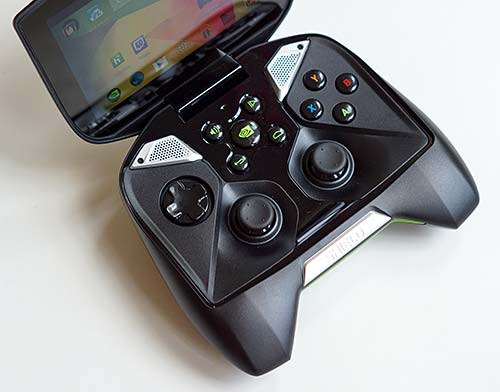|
Advertisement
|
Home > Android Tablet Reviews > NVIDIA Shield

NVIDIA Shield
What's Hot: Excellent game controller, extremely fast Tegra 4, long battery life, PC Streaming of games.
What's Not: Heavy, 5" display feels cramped if you're used to tablet gaming, PC Streaming requirements are stiff. Ergonomics suited for gaming but not great for other tasks like reading ebooks.

Reviewed August 6, 2013 by Lisa Gade, Editor
in Chief (twitter: @lisagade)
Editor's update August 2014: Read our review of the NVIDIA Shield Tablet, an 8" gaming tablet
The NVIDIA Shield is unlike any device. The 5" Android gaming handheld isn't the Sony Xperia Play since it has no cellular radio and it has a beefy controller that makes no concession to compactness. It's not the Sony PS Vita or Nintendo DS either since it's a full powered Android handheld with access to the Google Play Store and everything an Android can do: Office, ebooks, web, maps with GPS and of course all those Android games. It weighs a hefty 1.28 lbs. and the controller portion is modeled after the XBOX game controller. It looks like the offspring of an Alienware gaming laptop. It feels extremely rugged and I doubt the joysticks or display will snap off any time soon. (or possibly ever unless you're getting wicked with a hammer).

The Shield is the first product on the market to run the NVIDIA Tegra 4 with its 4+1 ARM Cortex A15 cores and crazy number of graphics cores. It benchmarks twice as fast as the fastest Android smartphones and tablets currently on the market: quadrant scored 18,854. 3DMark's Ice Storm test scored 19,342 and 105 fps for the demo test. Honestly, this is more speed than anyone needs in a smartphone or tablet today, but I'm sure the apps will eventually come. Eventually. However in a device like the NVIDIA Shield that's meant to play TegraZone games flawlessly along with other Android games and PC Streaming games from your desktop gaming rig's Steam Library, you'll want all the horsepower you can get. This little handheld can even play 4K video, though the 1280 x 720 display makes that pointless. It does have both Miracast wireless display streaming and a mini HDMI port so you can output the video to a bigger screen.
The NVIDIA Shield has dual band WiFi with MIMO and strong reception so latency in streaming and multiplayer games is minimized. It has Bluetooth 3.0, a GPS and a huge 7,350 mAh battery in the handgrip sections. It also has a fan, something we've never seen in an ARM-based mobile product. Happily you'll rarely hear it. The Shield has a microSD card slot and USB Host.
The AMOLED display is extremely crisp at 294 PPI, and it has rich colors and is extremely bright (bright enough to use outdoors). The Shield's display had better color saturation than our desktop's LG IPS monitor, so we're impressed. It's certainly a great gaming experience for those who don't prefer the bigger screen experience of a tablet tethered to a USB or Bluetooth game controller.
The Mother of All Mobile Game Controllers
The controller is console quality and it's every bit as big--there are no shallow PS Vita buttons or abbreviated hand grips here. The controller is modeled after the XBOX PC controller and it has the hoped-for shoulder buttons (two left and two right), A, B, X and Y buttons, two joysticks, a d-pad and a center cluster of dual purpose and Android buttons (game start, power, home, back and a volume key that triggers on-screen volume controls that can also be controlled by L1 and R1 buttons after hitting the volume button). It worked well for a variety of Android games that are controller-aware and it was great fun in games like ShadowGun THD, GTA III and the bundled Expendable Rearmed and Sonic 4 Episode 2. The controller has motion sensors, a six-axis gyro and the Shield has an accelerometer.

PC Streaming and Steam BigPicture
PC Streaming? We spent four hours trying to get that working with our 2 month old beefy desktop gaming rig, but while streaming game video and audio stream worked perfectly, the Shield's controller didn't work in supported games. As NVIDIA reminded us, this is a beta feature but we'd still like to see it working on a retail product. That said, they're working on squashing this bug and will release an update once they've found a remedy.
After we and NVIDIA failed to come up with a solution, they were kind enough to send us a Falcon NW Tiki gaming desktop that was pre-loaded with their GeForce Experience software and an NVIDIA GTX 760 graphics card, and that worked like a charm. Speaking of supported games, NVIDIA has a list of compelling titles that includes Skyrim, BioShock Infinite, Metro 2033, Resident Evil 6, Tomb Raider (2013) and Batman Arkham City. You'll need a fairly expensive desktop rig to be the Shield's streaming partner, making this more a handheld for serious gamers if PC Streaming appeals to you. The desktop must have at least an NVIDIA GTX 650 graphics card (sorry, ATI is out of the question, as are mobile GPUs used in gaming laptops), a solid CPU and a fast network connection with Ethernet preferred over dual band WiFi. You'll also need a dual band 802.11n access point according to NVIDIA. The list of restrictions means that casual gamers with multimedia desktop PCs or gaming laptops are left out.
What if your Steam library is slim? Then this product might not be for you if PC Streaming is a prime concern. Serious gamers probably do have a healthy Steam library and you can add non-Steam games to your Steam library, though there's no guarantee they'll work. Happily NVIDIA didn't partner with Origin, which can barely run correctly on the desktop without grievous bugs. One more caveat: your gaming PC and the Shield must be connected to the same WiFi network, so you can kick back on the couch to be closer to your family when gaming, but you can't play PC Streaming games from a hotel while your desktop purrs along at home. And yes, your desktop must be turned on for this to work. While the Shield is connected, the PC's resolution is set to 1280 x 720 to match the Shield, and you can't use your PC for other things or it will kick the Shield out. Yes, you'll need to enable beta mode in Steam, at least for now (that setting is under account settings).
|
Deals and Shopping:
Advertisement
|

